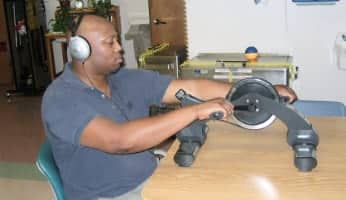Larry’s ALS Journey: Enhancing Quality of Life with Interactive Metronome Therapy

Home - Testimonials - Adult Testimonials - Larry’s ALS Journey: Enhancing Quality of Life with Interactive Metronome Therapy

Larry’s ALS Journey: Enhancing Quality of Life with Interactive Metronome Therapy
The Interactive Metronome® (IM) is a brain-based rehabilitation assessment and training program developed to directly improve the processing abilities that affect attention, motor planning, and sequencing.
This, in turn, strengthens motor skills, mobility, gross motor function and many fundamental cognitive capacities such as planning, organizing and language.
IM can be used to address a variety of degenerative, neuromuscular conditions, including ALS, Parkinson’s, Huntington’s and Alzheimer’s.
Larry’s ALS Symptoms
Larry’s symptoms developed slowly for years, including more and more severe fasciculations, difficulty manipulating his fingers especially when it was cold, and trouble with fine motor skills for tasks such as buttoning his shirt, tying his shoes, or snapping his fingers. After working as a steel fabricator and crane operator for 35 years, Larry attributed his symptoms to “arthritis.”
However, over the next 2 1/2 years it became gradually more difficult to lift heavy objects, to do intricate work with his fingers such as threading a needle, and it eventually became difficult to write. Shortly thereafter, Larry began to notice muscle atrophy in his hands and forearms.
After several EMGs and MRIs, Larry was given the devastating diagnosis of ALS.
IM Training at Home
Larry started receiving Occupational & Physical Therapy services on November 21, 2010 twice weekly. PT focused on conditioning and energy conservation. OT worked on overcoming basic obstacles in self care and ADLs, such as donning socks, shirts, opening door locks and creating something that would facilitate writing.
Larry was prescribed resting hand splints for use at night to manage muscle tone. PT was discontinued after a month and a half since most of Larry’s needs concerned use of his hands and his ability to perform self care activities and ADLs. After a few months, his OT recommended IM training to improve/maintain as much function in his hands as possible and to improve his balance. Larry had begun having some serious falls.
Larry participated in IM training in his home with his OT (Robyn) and then with a PT Assistant who consulted with Robyn after she went on maternity leave. This initial IM training lasted for almost a year at a frequency of 3 times per week for 6 months, then 2 times per week for the remainder of the year, with sessions lasting 45 min to an hour. The following year, Larry switched to a different home healthcare provider and began to work with Kim (PT Assistant) twice weekly.
There were a couple of extended breaks in IM training along the way that gave significant insight into the effect that IM training was having on Larry’s condition.
Fewer Falls with IM Training
During the first break from training, lasting a little more than a month, Larry reported an increase in serious falls, one resulting in cracked ribs.
He noticed that when he was participating in IM training on a continual basis without interruptions, he had far fewer falls. In fact, they were very infrequent and minor when they did occur.
The next break in IM training lasted approximately two months. Again, Larry experienced an increase in serious falls shortly after IM training ceased, one resulting in 19 stitches to his forehead. “IM therapy has improved my balance dramatically even though I have a degenerative disease.”
From the beginning of training with Robyn, IM exercises have been customized for Larry and designed to improve finger extension/flexion, wrist pronation/supination, shoulder abduction, forward reach and grip for increased strength, function and independence with ADLs and access within his environment (i.e., turning doorknobs, feeding himself). His therapists create each exercise to address a specific motor task that Larry is having difficulty accomplishing (i.e., turning doorknobs, feeding himself).
Fatigue level is minimal as long as the tempo does not exceed 54 beats per minute and repetitions do not exceed 40 for each exercise when they are first introduced. As new exercises are introduced or older exercises are reintroduced, special attention is paid to tempo and repetitions so that the pace is more gradual at first.
Larry has chronic pain due to multiple injuries sustained prior to ALS, and the muscle atrophy contributes significantly to his pain levels due to the lack of support of the injured areas. IM training exacerbates this pain, however it is managed very effectively during his training sessions with Electro Therapeutic Point Stimulation.
Customizing IM Exercises
Larry requires assistance from his therapist for donning the IM equipment (headphones, glove, etc.) and for placement of the triggers. The following are examples of how IM exercises are customized for Larry’s needs.
To work on finger extension, he rests his hand on a pillow while his therapist holds the trigger in place on the table. Larry extends his fingers to activate the trigger. For finger flexion Larry wears the trigger on his palm, flexing his fingers to activate the trigger. Wrist pronation/supination is accomplished by rolling his wrist onto the trigger that is placed on a tabletop (with the therapist holding it in place). This particular exercise is designed to help with turning doorknobs and to strengthen his wrists and forearms.
To simulate feeding, Larry rests his hand on his thigh, then raises it to his chin where the trigger is activated on his chin. Shoulder abduction is accomplished by strapping the trigger on the outside of his hand so that Larry can strike the back of a chair to activate the trigger. To work on forward reach, the trigger is placed in front of Larry and he strikes the trigger with his hand in the form of a fist while trying to keep his forearm, shoulder and wrist in alignment.
In addition to IM training, his therapists assign a wide range of exercises that vary according to his condition and limitations at any given time. For example, Larry completes exercises with a small magnetic resistance pedal machine, Thera-band, and door pulley exercises. Larry receives regular therapeutic massage and full range of motion from an LMT with specific training and experience with ALS. At one point during the early stages of IM training, Larry showed some reversal of ALS symptoms.
Results with IM Training
Prior to IM training, he had lost his ability to fully extend his fingers on both hands. After performing the customized IM exercises for finger extension with Robyn for about 2 1/2 months, Larry regained the ability to fully extend the fingers on his right hand and partially extend the fingers on his left hand. When Robyn went on maternity leave and he transitioned to the new provider in Jan 2012, the IM exercises for finger extension were omitted from his training plan, and he began to lose the ability to extend his fingers on both hands.
Those particular exercises were then reintroduced, and the finger flexion & functionality of his hands returned. As long as Larry continues IM training with emphasis on specific movement patterns, he maintains a higher level of function than he otherwise would.
IM training has enabled Larry to feed himself, to perform unassisted self care/ hygiene, and has contributed to overall better quality of life.
“I firmly believe that Interactive Metronome® has played a large part in stalling the progression of ALS and believe it should be a frontline defense therapy for early diagnosed patients.” – Larry




